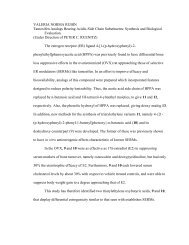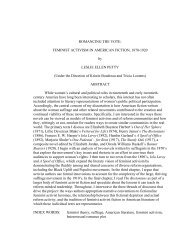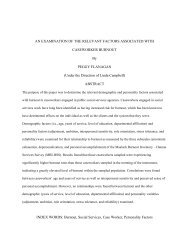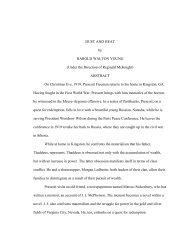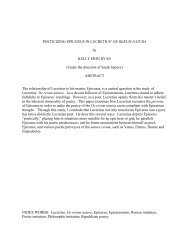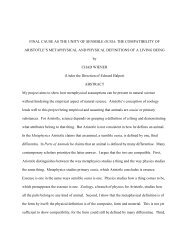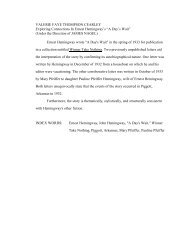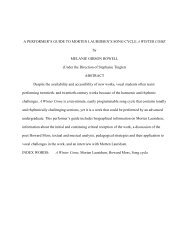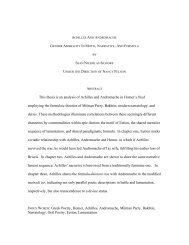A Parent's Guide to the Nitty-Gritty about Head Lice
A Parent's Guide to the Nitty-Gritty about Head Lice
A Parent's Guide to the Nitty-Gritty about Head Lice
You also want an ePaper? Increase the reach of your titles
YUMPU automatically turns print PDFs into web optimized ePapers that Google loves.
Reviewed March 2009
HOW TO AVOID A<br />
‘HAIR RAISING’ EXPERIENCE<br />
• Watch for signs of head lice. Check your<br />
children every few days if head lice are reported<br />
at <strong>the</strong>ir school. <strong>Lice</strong> are easier <strong>to</strong><br />
eliminate if caught early.<br />
• Teach your children not <strong>to</strong> share hats, headgear,<br />
scarves, headphones and grooming<br />
items (combs, hairbrushes, etc.) and <strong>to</strong><br />
avoid direct head-<strong>to</strong>-head contact.<br />
• To kill lice on bedding, clo<strong>the</strong>s, etc., wash<br />
and dry <strong>the</strong>m as you would ordinarily.<br />
NEVER add any pesticide. Vacuum materials<br />
that cannot be washed.<br />
• If you are concerned <strong>about</strong> head lice on carpets<br />
or furniture, vacuum <strong>the</strong>m thoroughly<br />
or wipe smooth surfaces with a damp cloth.<br />
• Wash stuffed animals or vacuum <strong>the</strong>m thoroughly.<br />
NEVER spray <strong>the</strong>m with a pesticide.<br />
• To kill lice on brushes, combs or hair accessories,<br />
wash <strong>the</strong>m with hot, soapy water.<br />
NEVER spray <strong>the</strong>m with a pesticide.<br />
• Cooperate with your school’s head lice policy.<br />
Your child may be temporarily excluded<br />
from <strong>the</strong> school , but <strong>the</strong> policy helps avoid<br />
widespread head lice outbreaks.<br />
10 TIPS FOR<br />
MANUAL REMOVAL<br />
1 Work in a well lighted area or use a<br />
flashlight and hand lens.<br />
2 Use a grooming comb or hairbrush <strong>to</strong> re-<br />
3<br />
move tangles. A hair detangler spray or o<strong>the</strong>r hair<br />
conditioner may aid in this process.<br />
Divide <strong>the</strong> hair in<strong>to</strong> sections and fasten off <strong>the</strong> hair<br />
that is not being worked on.<br />
4 Use a lice comb <strong>to</strong> detect and remove lice and nits.<br />
See figure 1 and figure 2 in this brochure.<br />
5 Go through hair sections from <strong>the</strong> scalp <strong>to</strong> <strong>the</strong> end of<br />
<strong>the</strong> hair. Nits are usually found close <strong>to</strong> <strong>the</strong> scalp.<br />
6 Dip <strong>the</strong> comb in a cup of hot, soapy<br />
7<br />
water or use tape <strong>to</strong> remove lice, nits or<br />
debris from <strong>the</strong> comb.<br />
Sift through <strong>the</strong> same section of hair and look for<br />
attached nits and live lice.<br />
8 Move on <strong>to</strong> <strong>the</strong> next section until <strong>the</strong> entire scalp and<br />
all hair has been checked.<br />
9 Screen <strong>the</strong> infested person every day for 10 days and<br />
regularly <strong>the</strong>reafter.<br />
10 If additional nits (at least 3-5 per day) are discovered,<br />
ano<strong>the</strong>r manual search is recommended.<br />
A PARENT’S<br />
GUIDE TO THE<br />
‘NITTY-GRITTY’<br />
ABOUT<br />
HEAD LICE<br />
THE UNIVERSITY OF GEORGIA<br />
COOPERATIVE EXTENSION SERVICE<br />
COLLEGE OF AGRICULTURAL AND ENVIRONMENTAL<br />
SCIENCES / ATHENS, GEORGIA 30602<br />
Paul Guillebeau and Gretchen Van De Mark<br />
Department of En<strong>to</strong>mology





